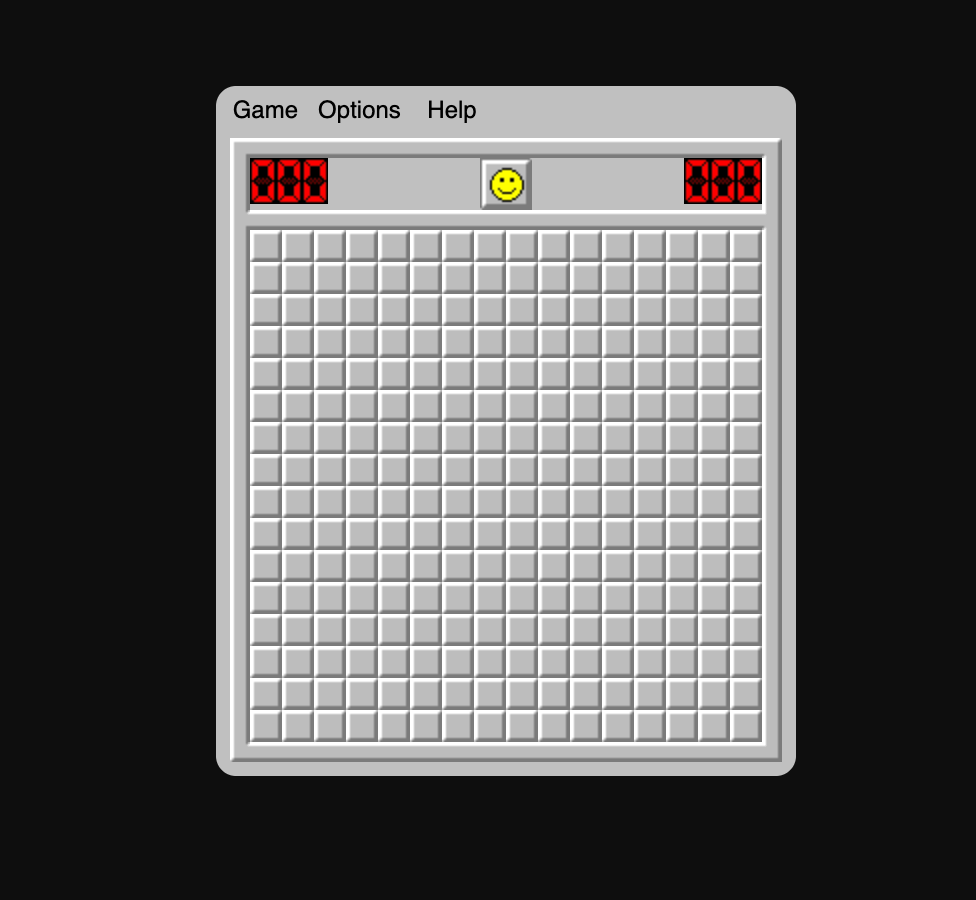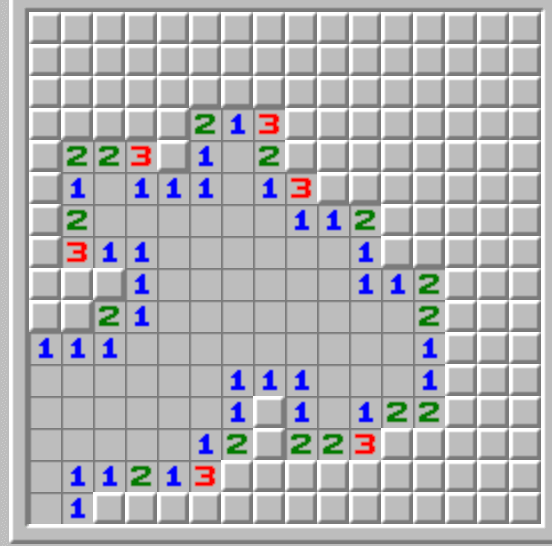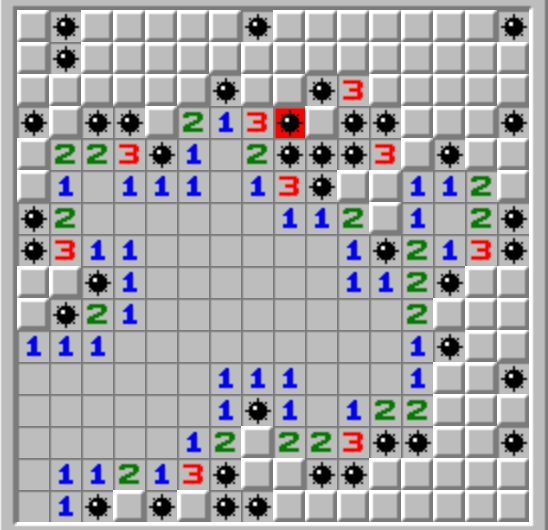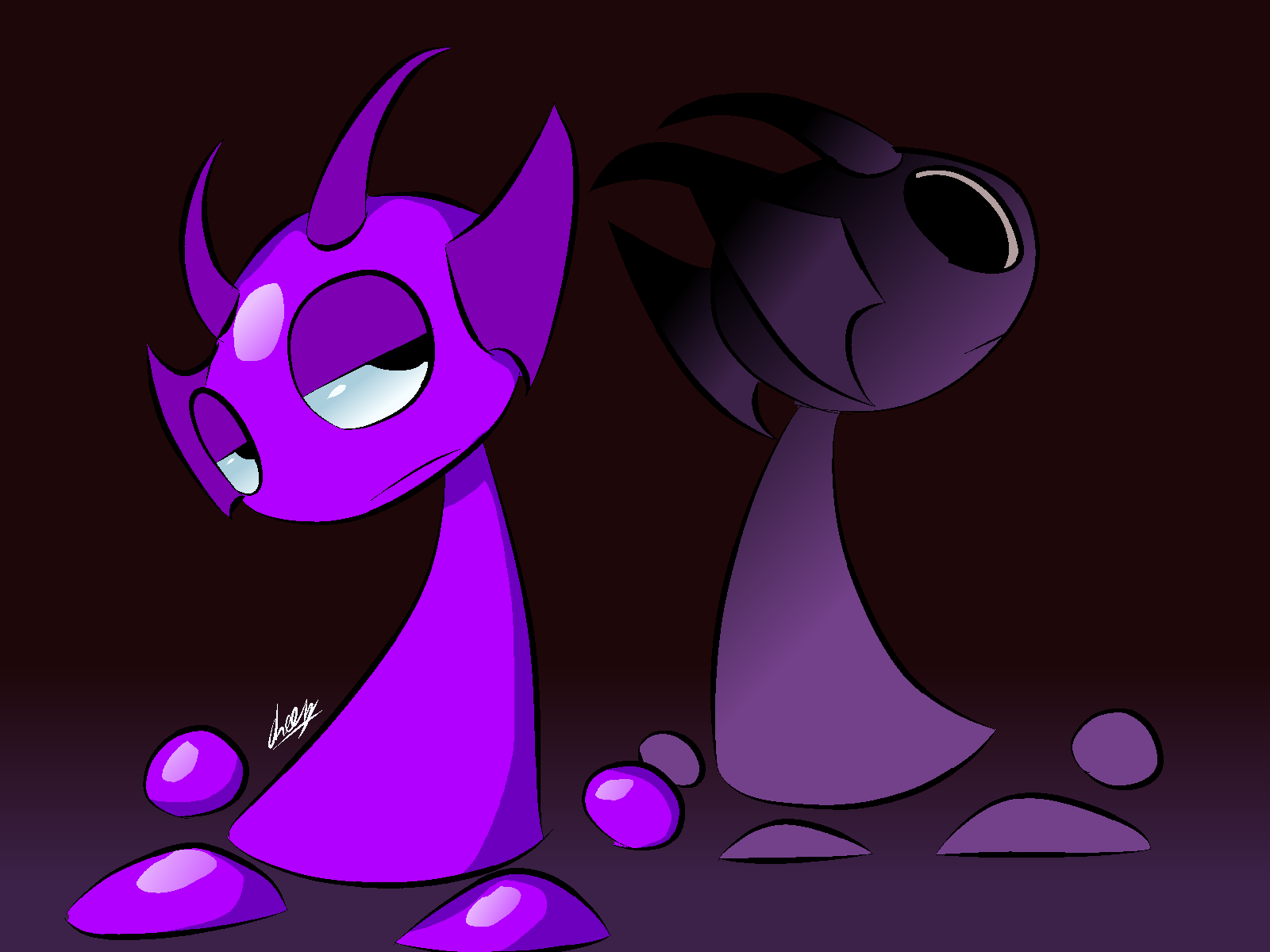 Minesweeper
Minesweeper
Minesweeper
Experience the classic logic puzzle Minesweeper in your browser, completely free and without downloads. First included with Windows 3.1 in 1992, Minesweeper has become one of the most recognized puzzle games in computing history, challenging players with its perfect blend of logic and probability. Whether you're a seasoned Minesweeper veteran or discovering this influential title for the first time, our online version delivers the authentic Minesweeper experience that has captivated millions worldwide.

How to Play Minesweeper
Master the art of mine detection with these essential techniques!

The Basics
Minesweeper challenges players to clear a rectangular grid containing hidden mines without detonating any of them. Left-click to reveal a square—if it's a mine, game over! Safe squares display numbers indicating how many mines are in the adjacent squares. Your first click in Minesweeper is always safe, often revealing a large opening to give you a strategic starting point. Use right-click to place flags on suspected mines, helping you track potential dangers.

Strategic Patterns
Success in Minesweeper relies on recognizing common patterns. When a number touches exactly the same number of unopened squares, all those squares must contain mines. After flagging mines around a number, you can use "chording"—clicking both mouse buttons simultaneously on the number—to quickly reveal all remaining adjacent squares. This technique dramatically increases your efficiency as you advance through Minesweeper's increasingly challenging difficulty levels.

Gaming Legacy
Minesweeper made its first Microsoft appearance in 1990 as part of the Windows Entertainment Pack, later becoming a standard inclusion with Windows 3.1 in 1992. The game's origins can be traced to earlier titles such as Mined-Out (1983) for the ZX Spectrum. Minesweeper's influence extends beyond its simple interface—it pioneered casual gaming for office workers and introduced millions to logic puzzles. Today, Minesweeper remains a benchmark for puzzle game design with numerous variants including 3D, hexagonal, and competitive speed-solving versions.
What Makes Minesweeper Engaging
These elements establish Minesweeper as one of the most enduring puzzle games in computing history.
Perfect Difficulty Curve
Minesweeper's three difficulty levels (Beginner, Intermediate, and Expert) provide a natural progression that grows with the player's skill. The game remains accessible to newcomers while offering serious challenges for veterans.
Logical Deduction
Unlike many games of chance, Minesweeper rewards careful observation and deductive reasoning. Players analyze number patterns to make safe moves, creating a satisfying blend of puzzle-solving and strategic thinking.
Pattern Recognition
Regular Minesweeper players develop the ability to recognize common configurations and make decisions quickly. These pattern recognition skills transfer to other problem-solving scenarios, making Minesweeper both fun and mentally stimulating.
Risk Management
Minesweeper creates moments of genuine tension when logic reaches its limits and probability calculations become necessary. Deciding when to take calculated risks adds a thrilling element to what would otherwise be a purely logical exercise.
Cascading Reveals
The satisfying chain reaction that occurs when clicking an empty square is one of Minesweeper's most gratifying mechanics. Watching large sections of the board clear automatically provides a rewarding sense of progress and momentum.
Competitive Depth
Beyond casual play, Minesweeper has developed a competitive scene focused on solving boards in record time. This community has created specialized versions like Minesweeper X and Arbiter that provide precise timing and statistical tracking for competitive players.
Minesweeper FAQs
Frequently Asked Questions about the classic puzzle game.
What is Minesweeper?
Minesweeper is a puzzle game where players uncover squares on a grid, aiming to avoid hidden mines. The goal is to clear all squares that don't contain mines, while using numbers on revealed squares to deduce the locations of the mines.
How do I play Minesweeper online?
Our browser-based version gives you the authentic Minesweeper experience without downloads. Left-click to reveal squares, right-click to flag potential mines. The first click is always safe, and the game is won when all non-mine squares are revealed.
What do the numbers on the board mean?
The numbers on the board indicate how many mines are adjacent to that square. For example, if a square shows a '2', it means there are two mines in the eight surrounding squares. These numbers are vital clues that help you deduce where mines are located.
What are the different difficulty levels in Minesweeper?
Minesweeper typically has three difficulty levels: Beginner (9×9 grid with 10 mines), Intermediate (16×16 grid with 40 mines), and Expert (30×16 grid with 99 mines). Our online version also offers custom levels where you can set your own grid size and number of mines.
What happens when I click on a square with no number?
Clicking on a square that has no mines nearby will clear the square and reveal adjacent empty squares and numbers in a cascading effect. This automatic reveal helps you quickly clear large sections of the board that are safe from mines.
How do I use flags effectively?
Flags mark squares you suspect contain mines. Right-click to place a flag and prevent accidental clicks on potential mines. While flagging isn't required to win, it helps track mine locations. Some expert players use the "no flag" technique, relying on mental tracking for faster completion times.
What is "chording" in Minesweeper?
Chording is an advanced technique where you click both mouse buttons simultaneously on a number that has been satisfied (all adjacent mines are flagged). This automatically opens all unflagged adjacent squares, significantly speeding up gameplay. Be careful though—if your flags are incorrect, this will detonate mines!
Is Minesweeper purely a game of skill or is there luck involved?
Minesweeper combines both skill and luck. While pattern recognition and logical deduction form the core gameplay, most games include situations where probabilities must be calculated and risks taken. You may eventually encounter 50/50 guesses that can't be resolved through logic alone.
Who created Minesweeper?
Minesweeper was originally created by Robert Donner and Curt Johnson and was first released by Microsoft as part of the Windows Entertainment Pack in the early 1990s. It became a standard feature in Windows 3.1 in 1992 and remained a Windows staple until Windows 8.
What are some Minesweeper variants?
Beyond the classic version, many variants exist: Minesweeper X and Arbiter are popular with speed players for their improved randomization and statistics tracking; 3D Minesweeper adds depth to the playing field; hexagonal and triangular versions alter the grid shape; and competitive Minesweeper focuses on solving puzzles in the fastest time possible.

